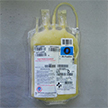
FFP is prepared by centrifugation of whole blood to separate platelet rich plasma (PRP); The PRP is further centrifuged to separate the plasma from the platelet concentrate. This plasma is then blast frozen to prevent loss of temperature-sensitive (“labile”) coagulation factors V & VIII. The separation of plasma within 6 hours of blood donation qualifies it to be called “fresh” and factors are best preserved in plasma blast frozen. Prathama have facility of blast freezing plasma. The blast freezer blasts cold air on to the plasma bag and pulls down the temperature from 25 degree celsius to less than -30 degree celsius in less than an hour. FFP can be stored at -30 degree celsius for 1 year.
FFP usage Indications
• Management of preoperative or bleeding patients who require replacement of multiple plasma coagulation factors (e.g., liver disease, DIC)
• Patients with massive transfusion who have clinically significant coagulation deficiencies.
• Patients on warfarin (an anticoagulant (blood thinner) that reduces the formation of blood clots. Used to prevent heart attacks, strokes, and blood clots in veins and arteries.) Who are bleeding or need to undergo an invasive procedure before vitamin K could reserve the warfarin effect or who need to have anticoagulation therapy after the procedure.
• For transfusion or plasma exchange in patients with Thromnotic Thrombocytopenic Puputa (TTP)
• Management of patients with selected coagulation factor deficiencies, congenial or acquired, for which no specific coagulation concentrates are available.
• Management of patients with rare specific plasma protein deficiencies, such as C-1-esterase.
Prathama ensures safe FFP to patients, as the same is collected from Voluntary Blood Donors (more than 40% repeat donors). Also ensures volume of FFP as high as 250-320 ml plus and good yield of most critical proteins. For FFP compatibility test is not required. Plasma must be ABO-compatible with the recipient’s red cells. Before issuing FFP to patients, it is thawed at 37 degree celsius. After thawing it should be stored at 2 – 6 degree celsius and must be transfused within 24 hours.
Sign up here to receive interesting updates
Subscribe to get updates!
Comments are closed.